When newspaper managements ‘back’ themselves
 This has been a bad week for the newspaper industry, says Mumbrella’s Tim Burrowes
This has been a bad week for the newspaper industry, says Mumbrella’s Tim Burrowes
As far as Australian newspapers go, this has been a most disillusioning week. I love ’em – but jeez, they make it hard.
Take last Friday. That was when it emerged that a designer on News Corp’s The Daily Telegraph had casually appropriated the image of a victim of a terrorist atrocity in order to poke fun at rival Fairfax columnist Mike Carlton.
Then there was the weekend, when News Corp’s The Australian decided it didn’t like the way self regulatory body The Australian Press Council (declaration of interest: we’re a member) was handling a complaint, so ignored the procedures it had signed up to, breached confidentiality and declared it had no confidence in chairman Julian Disney. (That’s the point of having an independent press watchdog, by the way: sometimes their decisions go against you.)
I know it can be easy to knock News Corp, or its individual papers. And like all big organisations, they’re capable of good and bad. I’ve loved The Tele’s campaigning stance on major issues like the western Sydney development (and I choose to buy it just about every day), and the half century presence of The Oz has added to serious national debate.
But I know not everybody sees it that way.
Every morning I pick up the papers from my local supermarket to read over coffee at my local hipster bakery before going to work. It’s a favourite part of the day.
The attitude of the staff at that supermarket selling me those papers is informative about what the public (or at least those in my latte-sipping corner of the world) think. Twice now, when one of the staff has been training a colleague serving me, he’s reminded them to congratulate customers who only buy Fairfax papers and berate those who buy News Corp titles. He’s kind of joking – but he’s not.
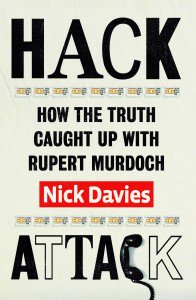 Now I must admit, at the moment it’s a bit too easy to know where he’s coming from. I spent the rest of the weekend reading the brilliant Nick Davies book Hack Attack about the phone hacking conspiracy at News Corp’s News of the World in the UK.
Now I must admit, at the moment it’s a bit too easy to know where he’s coming from. I spent the rest of the weekend reading the brilliant Nick Davies book Hack Attack about the phone hacking conspiracy at News Corp’s News of the World in the UK.
It’s so compelling, I found myself staying up til four in the morning to finish it.
Despite the fact that this was a single culture in a single newsroom, it’s hard for the reader to like the company at the end of that book. Given the many good people News Corp employs, I’m sure I’ll get over that feeling, but wow, that book makes the News of the World staff seem evil.
And Fairfax depresses me for other reasons.
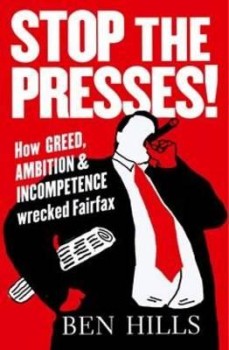 I’ve just finished Ben Hills’ book on Fairfax, Stop The Presses. I had thought that I didn’t have it in me to read yet another book about the decline of a once great publisher. But Hills found new ways of telling an old but sad tale.
I’ve just finished Ben Hills’ book on Fairfax, Stop The Presses. I had thought that I didn’t have it in me to read yet another book about the decline of a once great publisher. But Hills found new ways of telling an old but sad tale.
And indeed the best of Fairfax was on display at The Kennedy Awards last Friday night. This celebration of NSW journalism was rightly dominated by Adele Ferguson of The Sydney Morning Herald and The Age with her brilliant investigation into the shitbags in Commonwealth Bank’s financial planning team.
When it comes to the ethos of independent journalism, put me on Team Fairfax.
Yet Hills captured the contradiction in his book – often brilliant journalists let down by bad and self-interested management over the years. As they said about the British infantry in World War One, lions led by donkeys.
Which brings me to Monday morning.
Now, I live in the centre of Sydney. I’m as urban as it’s possible to be.
Yet at this major supermarket in the centre of Sydney, there were no Fairfax newspapers. They simply hadn’t been delivered.
The newsagent in the same shopping centre complex informed me they’d inexplicably received just one copy of Fairfax’s Australian Financial Review that day, and it had already been sold. Some days they just don’t arrive at all, he said. (To be honest, he didn’t seem that bothered – the queue for lotto tickets was pretty healthy at the time.)
So here we have Australia’s last best hope of keeping News Corp honest unable to do the one thing it’s been in the business of for the last 173 years – reliably delivering its newspapers to places that sell it in the centre of Australia’s biggest city.
On a Monday, the day the AFR and The Australian publish their media sections, this was frustrating.
It was also a depressing reminder of what life might be like when there’s only one major newspaper publisher left.
Then I came to work, where EMMA – Enhanced Media Metrics Australia – had released its numbers. It marked the one year anniversary since this metric – commissioned and paid for by Australia’s print publishers – launched.
And without a hint of a smile, the data was claiming that while print circulation might be down, readership was soaring.
Then on Tuesday came the turn of the measurement company which EMMA appears to have been set up to knock off – Roy Morgan Research. It tried to launch an eye-bleeding new metric claiming to link audience spend with individual magazine titles. It felt about as scientific as creationism.
But the biscuit was thoroughly taken on Thursday.
That was when Fairfax Media revealed its annual financial figures, which on the face of it showed some stabilisation.
The four top executives had been given big rises in their packages – about $2.4m. Bigger, according to the journalists’ union, than the total amount offered to the 600 journos in the company’s metropolitan newsrooms.
My colleague Nic Christensen asked Fairfax for a comment. Fairfax’s spin consultant Sue Cato, who advised “no comment”.
General counsel Gail Hambly (enjoying a total rise of $300,000, taking her up to a package of $1.063m) had her own views:
“Of course the aggressive response is that the increases are all incentive based- ie the management was prepared to back itself to achieve set targets- something the journalists are refusing to do. There were NO base pay increases.”
We know this because Cato accidentally forwarded the email chain to The Australian.
It’s worth at this point examining what Hambly – along with CEO Greg Hywood; Allen Williams, MD of the Australian publishing media division and chief financial officer David Housego – are actually backing themselves on.
The information is in the annual report.
Turns out that all four of them have the same KPIs. And one of those KPIs is reducing cost. Which in large part has been achieved by firing journalists and photographers, and making printers redundant by shutting the presses at Tullamarine and Chullora. (Or “cost reduction targets” as the report more benignly puts it.)
In Hambly’s case this directly makes up 10 per cent of her incentive. So, I guess she’s $37,500 better off thanks in part to all that crying in the lift Ben Hills wrote about. I’m sure those people working for her will be delighted she backed herself.
Luckily only five per cent of her incentive was made up of increasing the company’s revenue. I see it actually fell below $2bn for the first time in many years. Lucky for her she didn’t back herself more there. And luckily, all four still got some bonuses against revenue despite it going down.
Incidentally, those cost savings were worth $144,000 to Hywood, $99,000 to Housego and $46,500 to Williams. That’s without counting the additional dollars they got against their profit targets.
The observant reader of the report might also notice that the company has also just had its second worst profits result in the last five years. I’m not convinced that the turnaround is as complete as it tries to suggest.
Funnily enough all the buzzwords about content marketing and building the events business in the previous report were barely covered this time around.
Those staff mulling over how to react to their zero per cent pay rise offer may also like to reflect that the total pay for the top four rose by 58 per cent last year – from $4.1m to $6.5m.
Not by the way that I would claim myself able to do any better job. Hywood is playing the hand he has been dealt, with the board he has got, as well as anybody could reasonably be expected to. But the us-and-them nature of the “backing ourselves” comment points to a big divide between management and workers. Particularly when incentives are so skewed towards firing people.
Which brings me to today. And the quarterly newspaper sales figures, released this morning.
And to be honest, these make me feel sad rather than angry.
Print sales are still going down across the board, and digital numbers are going up nowhere near fast enough to make up the shortfall.
We get a bit more of of a picture from the fact that Fairfax revealed its paywall revenues yesterday – $24m.
Given that The Age and The Sydney Morning Herald are claiming digital subs of 255,000 across the two titles (and they won’t say any more what afr.com.au gets) this suggests each subscription is worth less than $2 per week. That’s not even a single edition of the paper.
And the growth curves are far too flat to suggest this will improve fast enough to offset the print declines.
Which is less than encouraging.
In truth, I bought the papers as usual today, and I’ll go on buying them tomorrow. There’s still a lot to love about them – and the people who produce them.
But when you find out what their bosses really think – and that “backing yourself” is hitting your bonus targets – it’s really hard to like the people they work for.
- Tim Burrowes is content director of Mumbrella





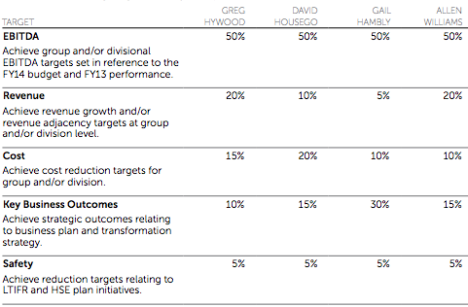
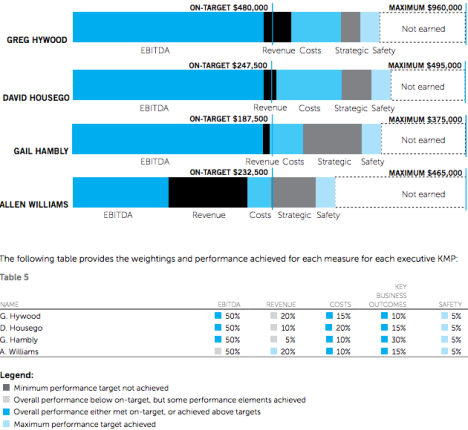
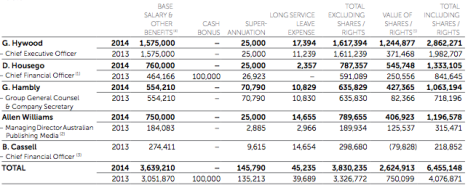
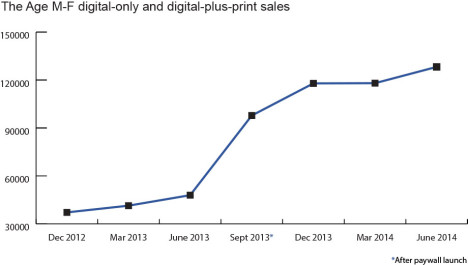
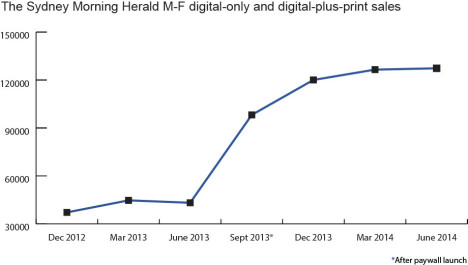
 Linkedin
Linkedin
I couldn’t agree more Tim. Yes, it’s traumatic to have to cut staff. And yes, it’s sometimes necessary for the business and people who have to do this unpleasant work should be remunerated in a way that takes into account the difficulty of the task. But the idea that your bonus increases on the basis of your capacity to sack people, and you somehow see this as evidence of your willingness to back yourself when the staff won’t, well that’s risible. Why are these people so tin-eared?
User ID not verified.
Well said sir.
User ID not verified.
Great Piece, Tim. All very well for Gail Hambly et al to argue that they are backing themselves by tying a big chunk of their remuneration to hitting targets, and that the journalists aren’t prepared to do this. I must have missed the bit where Fairfax management offered their journos the the opportunity to “back themselves” by giving them the chance to score massive bonuses on hitting certain targets?
And if fairfax management really were prepared to back themselves, they would actually reduce their base pay and increase the incentive component tied to targets. As it is, they’ve just kept their base pay unchanged and added a big fat dollop of cream on top. Nothing like leading by example, huh? Fairfax journos have every right to feel badly let down.
User ID not verified.
Yup, that’s where the Australian press is at – a pretty bad place.
I don’t want to sound unsympathetic to individual ethical journalists who are going to unjustly pay the price for their colleagues crimes but basically – the Australian public hates (I don’t think that’s too strong a word) and distrusts the press in this county. As we keep finding out more and more about unethical practices in Aussie journalism – Frankly it’s easy to see why. As everyone knows it’s a hell of a lot easier to lose trust than get it back – and the trust is dead now. Not only that, barely a week goes by without a major paper/publisher in this country beating up its corpse.
We talk about journalists being “let down” by their management who push them into unethical practices/unrealistic pressure – but how long can you blame it on your bosses until you decide to choose you’ve either got to stand up for ethical practice – or get a new job. I mean does the Australian Medical Association let itself get pushed around by hospital managers? Sure a little – but not to the level of scummy practice that is common in current Australian journalism. Journalist have the choice of taking a stand to win back the public’s trust or stand by watching their profession die because the public doesn’t buy information they don’t trust.
Its pretty obvious which choice is being made at present.
Look, clearly responsibility rests more firmly on management than journalists for the current state of play. But don’t underplay the danger posed by an honest individual. They can’t stop the race to the bottom, but they don’t have to take part.
User ID not verified.
Well said Tim.
On the one hand, I want to cancel my SMH subscription. On the other, I do want to support the work of the people . This is another example of corporate mismanagement on a grand scale. A disconnect between day to day people required to run the business and those intent on playing board games. Flogging assets – often wise investment decisions made under previous managements/boards – is by no means a performance worthy of a bonus if you’re selling it to stay afloat.
Corporate Leadership in Australia has once again taken another blow this month, CommBank being the start.
You’ve got to wonder whether it’s a sign of things to come.
User ID not verified.
Excellent story. One anecdote to add lack of professionalism at Fairfax; I live in Fairfax heartland less than 10km from the CBD, and stopped buying Saturday’s SMH a while ago because ridiculous deadlines meant they were unable to include results from the previous night’s NRL and AFL matches. Maybe we were getting country edition. Fairfax – taking the news out of newspapers.
User ID not verified.
Great article Tim – I was a 3 newspaper a day guy (AFR, OZ, SMH) for 20 years, but kicked the habit 5 years ago when I got an iPad.
All of the cost-cutting at Fairfax has seen a declining standard of sub-editing and a lack of depth of content. As a prime example, last week they published a preview of the EPL (English Football) which was entirely syndicated, and did not have any original Fairfax content.
They still have great columnists, and magazine sections like Good Living are fantastic, but it is hard to justify paying for it, when you can get it for free from Huffington Post and other overseas Web sites.
News…*sigh*
User ID not verified.
Capitalism is the failure here.
when your income is based on sacking people, youre going to sack people, meet your targets and get out.
The Media as we knew it is dying (possibly dead) we need an alternative. The society we live in is changing and we need an alternative
User ID not verified.
In another life a few years back I worked on the Fairfax business. I encountered the inevitable struggle between Marketing who were seeking to maintain & grow readership and increase circulation and Editorial who fought for journalistic integrity and standards.
Getting campaigns and readership promotions approved by Editorial was like going through a tooth extraction. There was no shortage of brands who wanted to partner with the papers but they made it incredibly difficult for anyone to give them revenue. When all parties finally agreed it was usually watered down and had an ‘Advertisement’ badge placed on it. Shock! Horror! We were trying to sell something!
Online papers were apparently the answer to capturing falling circulations as pages loaded with expensive madly flashing banners, page take-overs and irritating auto play videos would “engage consumers” but produced nothing but abysmal click-thru rates. Tim, your “less than $2 per day” from subscriptions sums up the dismal outcome for paywalls.
By this time the chest beating of journalistic integrity and maintaining standards faded away. Waves of people were sacked and replaced with marketing content writers and native advertising where the desperate publisher will disguise ads to make them look like news. Outcomes where consumers can not tell the difference are applauded in the hunt to find revenue that has steadily disappeared.
Perhaps it’s only a matter of time before brands will own the lead stories and believable, credible journalism will be a distant memory.
User ID not verified.
For those of us working at Fairfax, this is a huge slap in the face. Hywood and co have profited off the backs of journos, producers and staff who have spent the past few years adjusting to cuts to staff and budget, having to work harder to produce more out of less. Management keeps spruiking this digital-first strategy, while simultaneously imposing cuts to the digital staff. They talk about how our photojournalists are world class, then decide we don’t need to keep all of them.
Not to mention the effect all this has had on a mental scale, pulling long hours, neglecting sleep, being under constant pressure to feel the beast that is the 24 hour news cycle. When you see a typo on the site, it’s not the act of a careless hack who couldn’t be bothered to spell-check, it’s the oversight of someone who’s exhausted after working a 15 hour day with fewer resources and colleagues to help.
The awful thing is, many of us have and are willing to continue to break our backs for Fairfax, because funnily enough, we believe in speaking truth to power and delivering the news. And this is the thanks we get.
Fair go, Fairfax? Hardly.
User ID not verified.
@ Tony: digital subscriptions not generating less than $2 a day. It’s less than $2 A WEEK.
User ID not verified.
Get rid of the suits and hire amazing talent, encouraging them to invent, pay everyone fairly focus on digital: What both News and Fairfax should have done 15 years ago. Google beat em to it…
User ID not verified.
Thanks Tim. Eloquent and accurate and observant as ever.
As both a SMH and Rural Press alumni, I observed some absolutely woeful “yes-men”* get promoted to their particular level of incompetence (viz. Peter Principle.) * Yes, they were ALL men. Back in the 80s/90s to mid 2000s, it didnt really matter. The money rolled, the lunches were had. The stupidity reined, but the dedicated journos kept doing their thing and the readers kept reading. That era is now gone/deceased. Yours here is just one of the many obituaries being written.
User ID not verified.
As a former Fairfax employee and lover of the brand, the point missed in this article is that Tim’s opinion is nostalgic. I also went through the school of journalism where Fairfax media was hailed as the height of integrity and esteem. However that was in the age before the digital rise. I hate to see good journalists fired, but the business model has changed. Your reported figures show this and the decline in print is as much an audience caused problem as it is management.
Tim’s key point about raises goes to the managerial principles Fairfax is holding to, which I can not say is right or wrong based on now being outside the company. However its key to note in all print decline discussions that the glory days have passed and are not coming back. Consumers have moved on, even those of us who grew up with newspapers as key reliable sources of information.
This goes out to everyone, Fairfax management included, its time to stop looking to reclaim the past and think about the newspapers we want for the future and/or if they will play a role in future media. Tour any universities media lectures, newspapers are taught as old media, not what they should be focusing their careers on. Lets work with them, not hold onto the good old days. 173 years was a fantastic effort, but its time to look ahead.
User ID not verified.
@stantheman…you’re right…its even worse!
User ID not verified.
had to laugh at Sue Cato’s advice and undergraduate email error
it’s certainly not the first yet she manages to stay in business
I had to laugh because that’s the only advice she ever gives….either don’t answer a journo’s call, tell your PA that you’re out of town, or say ‘no comment’
in light of this her ongoing success is truly extraordinary
User ID not verified.
“I observed some absolutely woeful “yes-men”* get promoted to their particular level of incompetence”
Summed up perfectly @ C(d)L When the greedy fossils in charge, wearing blinkers and pinching the P&L with no regard for the audience, or overall staff EVP, you get what is happening now.
Any company with a ‘board’ is a load of old tosh.
User ID not verified.
The extremely obvious point here is that these managers don’t actually do the bits that earn the money. The cost cuts are delivered by the line management (and consultants!)_
Hambly has absolutely no right to pocket a cracker of bonus. It’s a joke. She is very clearly a LARGE cost reduction option. (Just check out what corporate counsel get at large companies.)
Hywoods pay should be compared with someone who is managing a business in transition. Like Thodey at Telstra, which is about a billion times larger. Thodey’s pay is MUCH harder to earn than Hywood’s. It’s also in line with the size of the business.
Clear it’s all down to Corbett, who needs to go soon.
User ID not verified.
Thanks Tim, another great piece. On the back of your Cannes/Scam award piece, 2 best editorials of the year so far
User ID not verified.
Seems like the General Counsel is a one-woman Cost Centre. How long will it take Australian businesses to learn?
Just because a self-selected few from a very shallow talent pool buy in their own language and metrics to invent their own success, it doesn’t mean the confridiocy passing itself off as adequate board-members should sign off on them.
User ID not verified.
Not surprised by anything the SMH does after the way it ignored the Rule of Law when dealing with Craig Thomson.
User ID not verified.
Have a look at The Age website today; Are big breasts a curse? And Sexercise. A great alternative to the gym? The disconnect between the print and digital products has always been vast and means a lost print reader will not necessarily become a new digital subscriber. That’s a big issue.
User ID not verified.
It’s very fashionable to bash News and Fairfax management for their response to the digital challenge. However I think this is a largely academic discussion given the massive changes we have seen in the market and readership habits. Management and staff restructuring exercises while having a huge impact on individuals are houses made of matchwood before a tsunami. The reality is low growth from here on. The golden days are over
User ID not verified.
For as long as everyone (bar a few, including Tim) refuse to pay for content fairfax and all the other media dinosaurs are doomed as they have no modern day business model that creates any form of sustainable business growth. Native appears to be their current hope but when hope is your only strategy you really are doomed.
It is easy to knock all the board on 7 figure salaries and bonuses but if anyone was in there position they would be doing exactly the same thing. All they can do is reduce costs and hope they are reducing at a greater rate than their revenue is falling. This will lead to further job cuts, pay freezes and when required selling the digital assets they have not already sold to help bolster their finances and make their annual statements look positive so that they maintain their jobs, salaries and lucrative bonuses.
User ID not verified.
I publish free independent newspapers in two regional cities and I can say without hesitation that on paper quality, design and profile alone in the local community, our papers get 9 out of 10 and the Fairfax papers about 3 out of 10. My observations is that the Fairfax’s of this world have had it so good for so long they now simply out of their depth when it comes to using business savvy. Business has always been about determining what the customer wants and then finding a way to deliver it while making a profit. It seems to me that most of the big publishers are determining what they want to give customers and then forcing it upon them. Instead of adopting building strategies they are following a cost cutting strategy and done out of balance, that’ll never work. With their resources they should have killed our publications off long ago, now it seems they may be considering closing some of their regional papers. Papers aren’t dead, the model that people want is changing…that’s all. Our model is working.
User ID not verified.